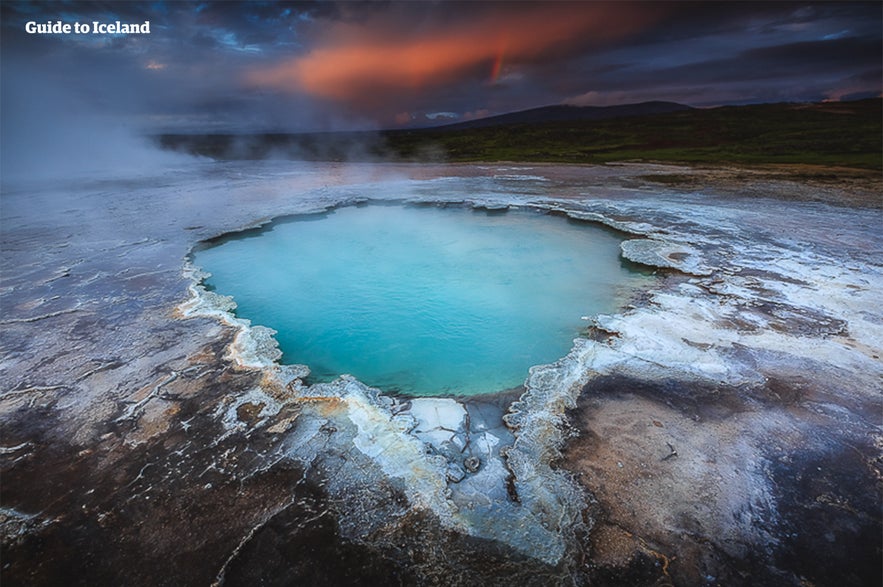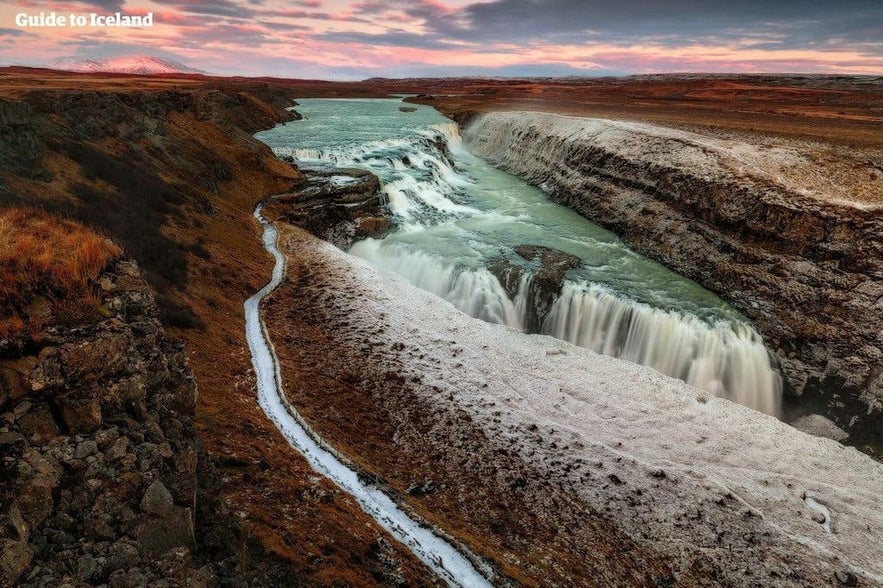El imponente Langjokull, el 'Largo Glaciar', es el segundo mayor glaciar de Islandia, con 935 km². Langjokull es el glaciar más popular de Islandia para hacer excursiones en jeep o en motos de nieve, con posibilidades también de esquí y rutas de senderismo.
Langjokull está a solo una hora en coche de Reikiavik, así que puedes alquilar un coche barato y conducir hasta allí por ti mismo para, por ejemplo, participar en excursiones en moto de nieve. También puedes apuntarte a tours y excursiones a Langjokull para conocer el glaciar de cerca y vivir las numerosas aventuras que ofrece. Si te interesan los glaciares, entra en este enlace y echa un vistazo a todas las excursiones a glaciares en Islandia. Sigue leyendo para enterarte de todo lo que debes saber sobre el glaciar Langjokull.
Por Qué Puedes Confiar en Nuestro Contenido
Guide to Iceland es la plataforma de viajes más fiable de Islandia, que ayuda a millones de visitantes cada año. Todo nuestro contenido está escrito y revisado por expertos locales que conocen profundamente Islandia. Puedes confiar en nosotros para obtener consejos de viaje precisos, actualizados y fiables.
Pistas de Montaña
El glaciar Langjokull se encuentra en las Tierras Altas, con dos carreteras de montaña que conectan el norte y sur de Islandia.
Por un lado, la carretera Kaldidalur se extiende desde el Parque Nacional Thingvellir hacia el norte hasta Husafell. La carretera Kjalvegur, por su parte, se ubica al este de Langjokull y al oeste del glaciar Hofsjokull. Comienza cerca de la famosa cascada Gullfoss al sur y atraviesa la increíble área geotérmica de Hveravellir, al norte.
Los Paisajes del Langjokull
El Langjokull mide unos 50 km de largo y llega a los 20 km de ancho, con 580 metros de profundidad que alcanza el hielo en su punto de mayor grosor. El glaciar alcanza su punto más alto en su parte más septentrional, llamada Baldjokull, que se eleva unos 1450 metros sobre el nivel del mar.
El glaciar se extiende sobre un macizo de montañas de hialoclastita. Las cimas de estas montañas se pueden ver en algunos lugares del glaciar. Oculta además al menos dos sistemas volcánicos activos, cuyas calderas son visibles desde el aire.
El más conocido de estos sistemas alimenta el área geotérmica de Hveravellir, al este de Baldjökull. Al este también se encuentra el campo de lava de Kjalhraun, que se originó hace unos 7800 años.
Al noroeste del glaciar existe otro sistema que produjo el vasto campo de lava de Hallmundarhraun, por el que discurre el río Hvita en dirección a la cascada de Gullfoss. Asimismo, en la zona se halla la cueva de lava más larga de Islandia, la fascinante Surtshellir.
Al suroeste del Langjokull se encuentra el campo de lava de Presthnukur, cuyas fisuras se arrastran bajo el hielo. Al sur del glaciar se ubica el campo de lava de Lambahraun y, aún más al sur, el campo de lava de Skjaldbreidarhraun y el volcán en escudo de Skjaldbreidur.
En comparación con otras regiones de Islandia, la zona se considera relativamente tranquila, con solo 32 erupciones en los últimos 10 000 años.
Dentro del Glaciar
Cerca de los picos más altos del Langjokull existen unos túneles de hielo artificial, un verdadero espectáculo para cualquier visitante que se aventure por el glaciar. Diseñado y construido por el geofísico y candidato presidencial Ari Trausti Gudmundsson, la existencia del túnel brinda a los visitantes la oportunidad de explorar el interior de un glaciar sin tener que viajar a Islandia en pleno invierno para poder adentrarse en el mundo de las cuevas de hielo, que no siempre es posible.
Aquí, los visitantes pueden atravesar la gruesa capa de hielo del Langjokull y vivir sus intensos colores azules para hacerse una idea de la belleza, la formación y los procesos que tienen lugar en un glaciar. Se trata del único lugar del mundo donde una experiencia de estas características es posible. Las excursiones Dentro del Glaciar ("Into the Glacier") se suelen combinar con actividades de aventura, como las motos de nieve.
Glaciares Cercanos
Los glaciares situados más cerca del Langjokull son el Eiriksjokull, que oculta la montaña más alta del oeste de Islandia, y el Thorisjokull. El Hrutfellsjokull también se encuentra en el lado este del Langjokull.
Entre el Thorisjokull y el Geitlandsjokull se sitúa un valle llamado Thorisdalur. Además de sus impresionantes vistas, ocupa un lugar destacado en los cuentos populares islandeses. Así, se dice que, por ejemplo, el forajido Grettir 'El Fuerte de la Saga de los Grettis' residió aquí durante un invierno.
Langjokull y el Círculo Dorado
La ruta turística más popular de Islandia, el Círculo Dorado (Golden Circle en inglés) no sería posible sin el glaciar Langjokull. Y es que ninguna de sus tres maravillas naturales existiría en su estado actual sin el deshielo.
La cascada de Gullfoss es el ejemplo más evidente. El río que la alimenta, el Hvita, es un río glaciar que fluye directamente desde el Langjokull. La magnitud del glaciar queda patente por el enorme volumen de agua que cae en cascada cada segundo.
Los manantiales de aguas termales de Geysir, por su parte, se abastecen de agua subterránea. El agua de deshielo del Langjokull alimenta los campos de lava circundantes, de roca muy porosa, que fluye en un río subterráneo hasta la zona geotérmica, donde sale a borbotones de las fumarolas formadas de manera natural.
Si bien Thingvellir conservaría su condición de Parque Nacional y Patrimonio de la Humanidad sin el Langjokull, al ser el emplazamiento original de lo que hoy día es el parlamento representativo más longevo del mundo, sería notablemente menos bello.
Existen numerosos manantiales por todo el parque, también formados por el agua subterránea de deshielo del glaciar. Debido a su largo proceso de filtración, el agua emerge como una de las más claras del mundo en estado natural.
Tanto es así que, la Fisura de Silfra es el mejor lugar del país para practicar snorkel y submarinismo, uno de los diez mejores del mundo para este tipo de actividades.











